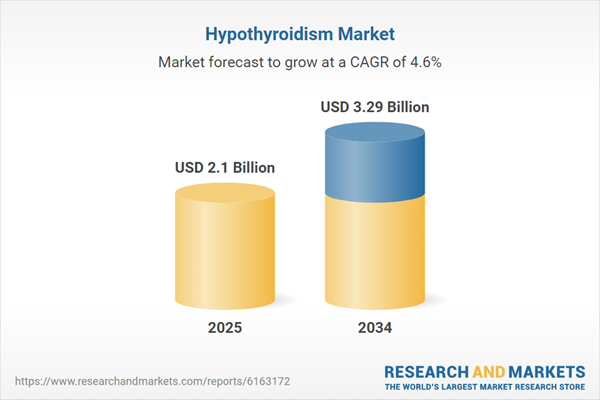Hypothyroidism: Introduction
Hypothyroidism, also known as underactive thyroid, occurs when the thyroid gland produces less thyroid hormone than needed by the body. This condition is commonly diagnosed by blood tests. Symptoms vary from person to person, depending on the severity. Common symptoms include weight gain, tiredness, dry skin, sensitivity to cold, constipation among others. Thyroid hormone medicines are frequently used as a treatment for the condition.Hypothyroidism Market Analysis
The hypothyroidism market demand has increased with the increasing incidence of Hashimoto's Thyroiditis, which is an autoimmune disorder impacting the thyroid gland and causing hypothyroidism.While levothyroa, the synthetic form of T4 hormone, is the most prescribed thyroid medicine, there has been focus on developing other effective medicines as well. Selenium supplements and thyroid hormone analogs, which help in hormone deficiency compensation and corticosteroids, are emerging as potential treatment alternatives in the market. Desiccated thyroid extract (DTE), a natural blend of thyroid hormone containing both T3 and T4, has shown positive results in trials.
Apart from drug administration, there have been significant developments to treat the condition on the cellular level. In September 2023, Sernova Corp., a clinical-stage cell therapeutics company, unveiled a new cell therapy platform called the ‘Cell Pouch System' to treat post operative hypothyroidism. Reimplantation of the thyroid tissue into the pre-vascularized Cell Pouch™ led to restoration of the thyroid hormones. The arrival of such technologies demonstrates that the hypothyroidism market value is projected to grow in the forecast period.
Hypothyroidism Market Segmentation
“Hypothyroidism Market Report and Forecast 2025-2034” offers a detailed analysis of the market based on the following segments:Market Breakup by Drug Class
- Levothyroxine
- Liothyronine
Market Breakup by Route of Administration
- Oral
- Parenteral
- Others
Market Breakup by Distribution Channel
- Wholesale Distribution
- Retail Stores
- Online Pharmacy
Market Breakup by Region
- United States
- United Kingdom
- Germany
- France
- Italy
- Spain
- Japan
Hypothyroidism Market Overview
Hypothyroidism affects approximately 5% of the global population with women being at a higher risk of getting affected. In the historical period, the United States has held a substantial part of the hypothyroidism market share. The increasing innovations in the medical field due to the existence of healthcare companies and research institutions, has largely contributed to the market growth.Europe is also leading the market with the help of significant initiatives taken by the government to spread awareness on early recognition of the disease. The region has a well-equipped healthcare infrastructure to support the rising medical demands owing to the geriatric population. Major mergers and acquisitions between influential pharmaceutical and MedTech companies are impacting the market positively.
Similar trend can be observed in the Asia Pacific region, that has been undergoing significant hypothyroidism market growth. In May 2023, IBSA launched an international campaign called “Feel Thyroid” to promote greater knowledge and understanding of the symptoms. The campaign aimed at improving communication between doctors and patients to identify the most apt therapeutic treatment for the patients. Moreover, increasing privatization in the healthcare sector is also expected to foster growth with several companies stepping in to develop effective therapeutics.
Hypothyroidism Market: Competitor Landscape
The key features of the market report include patent analysis, grants analysis, clinical trials analysis, funding and investment analysis, partnerships, and collaborations analysis by the leading key players. The major companies in the market are as follows:- AbbVie Inc.
- Merck & Co.
- Lannett Company, Inc.
- Allergan plc
- Mylan N.V.
- GlaxoSmithKline plc
- Novartis AG
- RLC LABS
- Abbott Laboratories
- Viatris
- Elexis
- IBSA Pharma
- Amgen
- Fresenius SE and Co.
This product will be delivered within 3-5 business days.
Table of Contents
Companies Mentioned
- AbbVie Inc.
- Merck & Co.
- Lannett Company, Inc.
- Allergan plc
- Mylan N.V.
- GlaxoSmithKline plc
- Novartis AG
- RLC LABS
- Abbott Laboratories
- Viatris
- Elexis
- IBSA Pharma
- Amgen
- Fresenius SE and Co.
Table Information
| Report Attribute | Details |
|---|---|
| No. of Pages | 350 |
| Published | July 2025 |
| Forecast Period | 2025 - 2034 |
| Estimated Market Value ( USD | $ 2.1 Billion |
| Forecasted Market Value ( USD | $ 3.29 Billion |
| Compound Annual Growth Rate | 4.6% |
| Regions Covered | Global |
| No. of Companies Mentioned | 14 |









